The Number Cards
Reading the Number Cards
Each one of the four minor suits contains nine cards numbered from two to ten. In the Tarot de Marseille and in other traditional decks, the number cards have a relatively simple and abstract design. Each card shows the suit symbol in a number of copies equal to the card number. The suit symbol icons are arranged in a geometric array and surrounded by plant decorations. For example, the 3 of Cups shows three cups arranged in a triangle, the 2 of Wands shows two crossed rods, and so on.
Before studying their illustrations in detail, it may be difficult to tell the number cards apart. Not only do the cards of each suit resemble each other, but we also may get confused between the number cards of the wands and the swords. This is because all the wands and most of the swords are illustrated as narrow stripes with black blades at the tips. The difference is that the stripes of the wands are straight and cross over at the middle of the card. In contrast, the swords’ stripes are rounded and cross over at two points — at the top of the card and at the bottom.
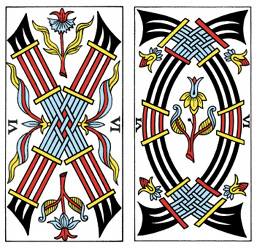
6 of Wands (left), 6 of Swords (right)
The simple design of the number cards can make them quite challenging to interpret at first. This is especially true for readers who have experience with Waite’s and other new English decks, in which the number cards are illustrated with realistic scenes of people and objects. These scenes, completely different from the traditional design, show various life situations and have a relatively narrow range of possible meanings. This makes them easier to read for beginners. In the Tarot de Marseille, on the other hand, novice readers often postpone the detailed study of the number cards to a later stage, after having gained some experience with other parts of the deck.
Tarot authors from the French school who have written about the Tarot de Marseille number cards have often combined two different methods for interpretation. These are similar to the two methods already mentioned in chapter 9: interpretation by the table and interpretation by the image. In the number cards, interpretation by the table means that each card represents the numerological significance of its number, acting with the character or in the domain of its suit. Thus, for example, the 3 of Coins symbolizes dynamism and advance (the number three) in practical matters (the suit of coins).
The interpretation by the image is similar in spirit to what we did with the aces and the court cards. Looking at the card, we notice the arrangement of the suit symbols and the emotional tone suggested by the plant decorations. These are interpreted as symbolizing events and processes in the querent’s life.
For example, we can read the following story in the image details of the 3 of Cups:
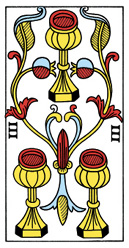
The pair of cups at the bottom can signify two lovers. The sensual red shape in the middle indicates mutual passion. The heart shape of the leaves around the red shape’s tip expresses emotional bonding, but the little leaves above the heart — red on the right and white on the left — represent differences between the two partners. They turn in opposite directions, indicating the start of a separation.
The card’s answer to the situation is to produce a common creation; for example, a child or a common work project. This is signified by the third cup. Now the branches turn inward again, with pomegranate-like fruits on their tips, creating the shape of a bigger heart. The outer edge of the top right-hand leaf is white, mirroring the small white leaf at the center left. It is as if the right-hand partner assimilates the higher qualities of the other, which at first were rejected.
We can also look at the story from the perspective of the third cup. The querent might have grown up as a child with such a relationship between the parents. Since he functioned as the glue holding them together, they cared for him and gave him lots of attention. But from his point of view the excessive attention could be felt as too much, blocking him from all sides and letting him develop only in a very defined direction symbolized by the top opening.
The Language of Directions
In chapter • 4 we interpreted the horizontal axis of the cards, left to right, as the time direction of earthly events. The vertical axis, bottom to top, we saw as representing the inner experiences of the soul. This scheme is appropriate especially for the major suit cards, but we also can apply it to the aces and the court cards. The court cards express the vertical axis in a very limited way, as they show no sky and no abyss, but this is only natural, as they present people in practical life situations and don’t refer to the psychological and spiritual dimensions.
The same interpretation for the axes is unsuitable for the number cards. On one hand, their illustrations don’t show any development along the horizontal axis, as they are almost symmetrical between left and right. Instead, we can see variations in the details along the vertical axis, often with a sense of growth and advancement from bottom to top. In other words, only the vertical axis is significant in the number cards. On the other hand, the simple and basic design of the number cards suggests that we should interpret them mainly in terms of concrete and external events. This makes the interpretation of the vertical axis in terms of internal processes irrelevant for the number cards.
What we need is a new interpretation of the vertical axis that is specific for the number cards. We can think of two such interpretations, which may be appropriate in different situations.
Inspired by the upward movement in many cards, we can interpret the vertical axis in the number cards as a time direction. For this we can imagine the number cards as lying flat on the ground, one after the other, like large bricks paving a road. As we advance on the road, we pass through each card from bottom to top. In such a vision the bottom part of the card represents the past or an early stage in a process, while the top part represents the future or a later stage. In other words, we interpret the vertical axis of the number cards as a time axis, similar to the horizontal axis in the other parts of the deck.
In the number cards of the soft suits, coins and cups, we can find another meaning in the vertical axis. In these cards up and down can be interpreted in terms of power and status relations. Naturally, we would see the stronger or more influential element on top and the dependent or subordinate at the bottom. For example, the 7 of Coins may show the querent’s position at work as the single coin in the middle, protected and relatively well placed. The 8 of Coins can remind us of an office building or a big organization, with management on top and employees at the bottom. In the 10 of Cups we see one big cup on top of nine small ones, and we can interpret it as a leadership position.
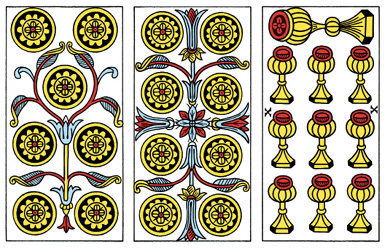
7 of Coins, 8 of Coins, 10 of Cups
Another feature of the vertical axis in the number cards concerns inverse cards. Some number cards are almost symmetrical between top and bottom, with only slight differences in the decoration. In these cards it is difficult to distinguish between a straight and an inverse position. Other number cards show a clear distinction between straight and inverse. For example, when a number card from the cups suit is inverse, its cup icons are turned down, which makes a big difference.
As the distinction between straight and inverse is very clear in some cards but not in others, should we consider it in a reading? My way of dealing with inverse number cards is to distinguish between the two cases. With cards that are roughly symmetrical, I usually give the same interpretation regardless of the card’s position. I make an exception to this rule only if I have a spontaneous intuition about the interpretation of a minor difference in the details. On the other hand, if the illustration is clearly asymmetrical, I give a separate interpretation to an inverse card. As I do with other parts of the deck, I usually give an inverse card a less favorable meaning than if it were straight.
Although each suit has its typical design, as we shall see in the next section, there are some features that are common to different suits. One of the most significant among them is the distinction between even and odd numbers. In the even-number cards the suit icons are usually arranged in pairs, giving the card a solid and stable character. In the odd cards a single suit icon appears between the pairs, disrupting the stable structure and creating a more dynamic and tense impression.
It is useful to distinguish here between the soft and the hard suits. In the soft suits a single pair (two icons) can indicate an alliance, a partnership, or two opposing forces. Several pairs can represent an environment or a system within which the querent operates. A single icon in an odd card may symbolize an individual person or a singular element in the situation. It can also refer to the querent’s relationship with their environment. For example, a single cup can represent the querent’s relationship with family, and a single coin can symbolize their position at the workplace. This expresses the fact that the cups refer to a web of human and personal relations, while the coins indicate a system based on practical and material considerations.
In the hard suits we can see the singular icon as an individual facing a challenge or opposition. The single wand in the odd-number cards can symbolize the querent’s path, which is crossed by two bundles of wands, representing challenges and difficulties. Alternatively, it could be a single wand warding off an attack by others who are crossing the querent. The single sword of the odd numbers is breaking out from a limited area enclosed by pairs of rounded swords. We can see the sword pairs as limits and boundaries that block or protect the querent. As for the single sword, it can represent an initiative to break through the existing barriers and advance toward new territories.
The first and last numbers, two and ten, also present similar traits in different suits. As we shall see further on, card number ten has a unique design that somehow resembles the odd cards of its suit. Although this is more noticeable in the hard suits, we can see something of this in the soft suits as well. As for the number two cards, in the soft suits their designs are unique and show more complexity and richness of detail than other cards. In the hard suits this particular characteristic of the number two cards is not evident; rather, they have the same structure as the others.
Another trait of the soft suits’ number two cards is the presence of writings that can be read as some sort of signature or acknowledgment. Traditional Tarot de Marseille makers often decorated the 2 of Coins card with a band of text displaying the name of the deck creator or publisher, the year, and the place of publication. Conver also did this in his 2 of Coins card, and in the CBD deck I added my name to his. In some older decks the publisher’s details appear not in the 2 of Coins, but in the bottom part of the 2 of Cups. The Conver deck also has text at the bottom of the 2 of Cups, but it is just the letters G and M. Perhaps they were intended to convey some message, but they could also very well be just another signature. For example, maybe these were the initials of an artisan who carved the wooden printing plates.
In addition, the bottom part of the 2 of Cups shows a shield with three fleurs-de-lys or stylized lily flowers, which is the coat of arms of the royal French house of Bourbon. The shield is mounted by a crown and decorated with two branches, similar to those that appear in the Ace of Swords. The Bourbon shield itself appears again in the 4 of Coins. There may be a connection between these heraldic emblems and the fact that cards were printed in France under strict royal supervision at that time. Still, in a reading everything is a sign, and we can interpret these details in a different context. For example, the royal symbols can represent the established powers and institutions in society. The letters G and M can hint at a name or a concept relevant to the query.
The Four Suits
The number cards of each minor suit display a typical design structure that evolves along with the progression of card numbers. When we begin to study the number cards, it is a good idea to arrange each suit in a row according to the card numbers. Looking at the nine number cards of the suit, we can have an impression of their common structure as well as of the differences that give each card its individual character.
coins
In the number cards of the other suits, the card number appears on both sides in roman numerals. But in the suit of coins the number is not written, and to identify the card one simply has to count the number of coins.
Except for the two card with its large and detailed coins, all the coin icons in the number cards have the same design. On most of the cards they are arranged in a uniform and symmetrical pattern with pairs piled up on top of each other. This creates stable structures suggesting solidity, reliability, conservatism, and rigidity. The yellow coins give the cards an illuminated and optimistic character, and one can naturally see them as gold coins. Besides other possible interpretations, we can see large numbers of coins as indicating a large sum of money or perhaps an extensive involvement in practical or financial issues.
In the 2 of Coins card it is natural to see the two large coins as two elements. They are held together, but also separated from each other, by the snake-like band. In the 3 of Coins we can see a new coin emerging from the alliance of the pair below.
In the higher numbers we can see a system or an environment evolving through different phases. The solid square in the 4 of Coins with the royal shield at the center suggests a stable structure based on conventional norms. In the 5 of Coins a new element appears in the center, disrupting the stability and creating a space for itself.
The 6 of Coins can symbolize a more flexible and dynamic organization, deviating from the design of layered pairs and presenting a more harmonious and rounded arrangement. Adding the single element in the 7 of Coins, we can see it receiving its own place in the middle of a layered pairs structure. It is well placed but not central, and the plant decorations around it suggest harmonious integration, cooperation, and support.
The 8 of Coins shows a complex structure with a uniform and hierarchical arrangement. It symbolizes another form of rigidity, mechanical and impersonal. In the 9 of Coins we see again a single element, but now its space is squeezed and limited in the middle of the well-established structure. If we think in terms of a conflict between an individual and a system, we can see a pattern that repeats itself in the other suits as well. In the five card the single element is facing four others, but its uniqueness gives it an edge, and it is strong enough to win over them. In the seven card the single element is up against six, and the forces are equally balanced. In the nine card it is one against eight, and now they are stronger.
Finally, in the 10 of Coins we see harmony restored, with an abundance of coins. It can be individuals integrated in a system, like the two single coins along the middle axis, each of them well placed at the center of its own square. We can also see in the middle of this card a repetition of the harmonious arrangement of card number six surrounded by the solid and practical four.
cups
The yellow color of the cups gives the number cards of this suit an illuminated and happy character. Their red openings express passion and energy, while the shading inside the cups may hint at complex feelings. Perhaps things inside are not as simple and bright as they seem from the outside. We can also see the cup icons as golden cups full of red wine. Thus, a large number of upright cups can suggest a feast or festivity and symbolize happiness and a feeling of plenty, both material and emotional. Still, the cups can stand for deeper and sometimes darker emotions. In some cases they may be seen as full of blood or we may suspect that the wine might be poisoned.
A clear distinction between straight and inverse cards exists in all the number cards of the suit. An inverse card can signify negative feelings or emotions that play an obstructive part in the querent’s life. The down-turned cups in an inverse card can also indicate the loss of emotional energy, despair, or dryness and inability to experience emotions.
When we see a pair of two cups, one beside the other, it is natural to interpret them as a relationship between two people. It may be a romantic relationship or another form of alliance or partnership with an emotional dimension. Alternatively, we can see in the cups two parts of the querent’s emotions (for example, a case of conflicting feelings) or relations between two groups of people.
Repeating pairs in a card can be different stages in the evolution of a couple’s relationship. They can also represent several couples; for example, several generations in an extended family. In the case of bigger groups of cups, they can just represent a group without each cup necessarily referring to a particular person. For example, a row of three cups may symbolize a group of people (not necessarily three) in the querent’s surroundings.
The large pair in the 2 of Cups may represent two people in a partnership or a love affair. The lower part of the card, with its reference to royalty, suggests this relationship does not exist in an empty space. It has its basis in the norms and institutions of society; for example, the perspective of an eventual marriage, which is a social institution. In the 3 of Cups we can see something new that is born from the union of the two. For instance, it can be a child or a mutual project.
The 4 of Cups shows a solid structure of personal relations; for example, a family or a group of friends with a common history and a feeling of commitment. In the 5 of Cups we see an individual placed in the middle of a group. The rich and happy plant decorations indicate a key position and positive influences. The 6 of Cups has a strong central axis, which gives direction to the columns of cups on either side. The feeling is of continuity and repetition; for example, a long-term relationship.
In the 7 of Cups the single icon in the middle is more isolated, but the lively plant decorations around it suggest a uniqueness turned into an advantage. The 8 of Cups shows two central cups between two tiers, perhaps a couple or a partnership of two with many other people meddling in their affairs. In the 9 of Cups we can see a large group in which each individual finds his proper place, without any one of them in particular standing out. In the 10 of Cups we see again the same crowd, but now our attention is focused on the large single cup above, apparently lying on its side, which may represent someone in a leading position.
wands
The straight rods with the black blades at both ends suggest some kind of fighting sticks. Their crossing over in the middle can symbolize conflict and struggle. Alternatively, they can be roads or pathways on which we can walk. In this perspective the black divergent tips can signify uncertainty about the continuation of the road, as it may diverge in different directions as it reaches the limits of the card. The dominant black and red colors indicate that the roads may be difficult and full of hardships and trials. On the other hand, most of the cards present plant decorations whose lines of growth lead from the center outward. Thus, the struggles and difficulties can be connected with growth, creativity, expansion, and perhaps the discovery of new horizons.
As the number of wands increases, their crossing at the center becomes larger, denser, and more dominant. In the higher numbers it looks like a mesh of crisscrossing wand sections. We can interpret this as a complex situation in which many elements and interests are entangled. In such a reading the crossed wands symbolize obstacles or opponents. The mesh can also appear as a maze of paths in which the querent has difficulties finding their way.
A single wand in the odd-number cards can look like a road, which the querent traverses from bottom to top. They enter the crisscrossed mesh at the center from below and emerge again above. This can be like passing through a period of confusion, conflict, or hardship. In the even numbers the central axis is marked by two branches above and below. We cannot see a single road passing through, and the card may represent the complex situation itself, rather than a dynamic process in which the querent enters and gets out of a difficulty.
The wands crossing each other can also be fighting sticks locked in a struggle. For example, the 3 of Wands can be one person in the middle of a conflict between two others. The 7 of Wands can be one person standing against a coalition of many. Still, in the wands suit we see only conflicting interests or opposing wills. It is not actual war in which the intention is to hurt or destroy the enemy, as we might see in the swords. Also, as the suit of wands is related to drives and desires, we can interpret the card images as patterns of desires and passions. For example, the 2 of Wands can signify two urges pushing the querent in two different directions. In the 8 of Wands we can see a web of complex, intertwined, and conflicting desires in which the querent is caught.
In the 2 of Wands the crossing of the wands is a simple intersection with no meshing. The plants growing in all directions are more prominent than the black blades. The short yellow bands separating the wands into sections have rounded ends. This gives them a soft aspect in contrast to higher number cards in which they are rectangular with sharp edges. The impression is colorful and optimistic, and it suggests a crossing of ways open to all sides.
In the 3 of Wands a single wand passes through the crossroads, marking a clear and well-defined direction. In the 4 of Wands a mesh now appears at the center, but it is relatively simple and looks solid and reassuring rather than confusing. The plant decorations are rich, suggesting growth and creative energy. In the 5 of Wands the growth diminishes, and a single wand passes through the center. It seems to be on top of the perpendicular yellow bands just above the central mesh, covering their inner edges, as if overcoming their attempt to block its way.
In the 6 of Wands the plant leaves on both sides and on top become long and narrow, still expanding but as if constrained to follow the direction of the wand bundles. The 7 of Wands shows a single wand passing at the center, but the yellow leaves with sharp metallic-like tips signal tension. Also, the central wand’s segments are not exactly aligned but rather form a broken line. It is as if the central wand is passing through but with difficulty.
The 8 of Wands shows a thick central mesh that now becomes the strongest element in the card. This suggest a complex and confusing situation, like a maze of roads crossing each other, in which the querent can lose their way. The 9 of Wands shows no plant decorations, and the single wand is cut by the central mesh into two segments, one above and one below. If this is a road, it is interrupted by the mesh and has to start anew after the challenging period is over. We see again the same pattern as in the odd coin cards: in the five the single one overcomes the four, in the seven it is balanced by the six, and in the nine it is overcome by the eight. Finally, the 10 of Wands presents two joined wands entering the mesh and coming out together. It is as if loyalty binds the two and helps them pass through the opposing eight.
swords
In the even cards of the suit, the swords appear as two bundles of curved parallel stripes forming an oval enclosure. At first sight, it is even difficult to recognize these shapes as swords. This could be a remnant of the origin of the minor suits in Asian countries, where curved swords, or scimitars, were common. In the odd cards an additional straight sword commands the center with its tip projecting out of the oval enclosure. The 10 of Swords is the exception with two bundles of four curved swords, plus two slanting straight swords with their tips pointing inward.
The bundles of curved swords cross over both above and below the card center, thus they separate the card into two parts, one inside and the other outside the oval enclosure. As the card number increases, the separating barriers become thicker and denser, forming a grille of sorts. In the higher numbers they begin to resemble prison bars. In the outer part of all the cards there appear four stemless flowers with five sepals each. This structure resembles the World card from the major suit, with an oblong space in the middle and four animals around it. We can also see the four five-sepaled flowers as symbolizing hands and feet.
The separation between an internal part and an external part emphasizes the cutting character of the suit of swords. It can also symbolize the role of language and rationality, which divide our experience of reality into an inner part (our mind) and an outer part (external circumstances). The hinted limbs can represent the querent’s actions (hands) and the external conditions (feet, what they are standing on). Alternatively, the separation could be between an inner sphere, such as the space of private life, and an outer sphere of public activity.
The grille-like barriers formed by the intersections of curved swords can also indicate that the querent is blocked or confined inside a limited space. For example, it can be a relationship or a job that the querent wants to leave but doesn’t know how. Another option is to think of the querent as actually being outside the enclosed area. In that case, what is inside can represent a hidden treasure or asset that they want to reach, or perhaps a part of their personality to which they have no conscious access.
The stripes of the curved swords are crossed over at several points by small perpendicular bands, which look as if they are holding together the bundles. Similar bands also appear in the wands number cards, but there are some differences between the two suits. In the wands suit card number two has bands with rounded edges, while in the other numbers the bands are rectangular. The rounded-band edges give the card a softer appearance. In the swords suit rounded bands appear both in two and three. In the other cards the edges are rectangular, but in the higher numbers the bands themselves become curved. Also, while in the wands suit all the bands are yellow, in the swords suit some bands are yellow and others are red. It is difficult to see a regular pattern in this coloring, but its perceptible effect is that a higher number of red bands create a stronger feeling of tension in the card.
In the odd cards of the suit, we can interpret the single sword sticking out from the central enclosure as an effort to break out and free oneself from the confined space. This effort becomes more difficult and challenging as the number of arched swords increases. When the card is straight, the tip of the single sword points upward, and then it may express success. In contrast, an inverse card with the tip down can indicate a failed or misguided attempt to overcome the barriers. Where the single sword passes through the upper bundle crossing we can see red diamond shapes, but only in the 5 of Swords can we actually see the blade passing through. A similar red shape also appears in the two crossings of card four and on the bottom crossing of card five.
The use of swords as weapons suggests an interpretation of the suit’s number cards in relation to wars and combat. These can be clashes with other people, the querent’s struggles against difficulties, or inner conflicts. Alternatively, we can follow the suit domain and interpret the cards as structures or patterns of thoughts and ideas. For example, the 2 of Swords with its symmetric flower developing within borders can signify a developed framework of ideas in a well-defined field, such as a scientific theory. The 5 of Swords with a single sword breaking out of the four arches can represent a breakthrough idea. The 10 of Swords with two crossed swords entangled in the dense side bundles can represent an argument that has been going on until nothing new can be said anymore.
In the 2 of Swords the inner part of the card is bounded by a single arch from each side, with a well-centered and symmetrical flower growing inside. The borders around it seem to be marking its space rather than limiting its growth. In the 3 of Swords the single sword is decorated with branches and does not seem to be hindered by the pair of arches as it passes through. This can indicate an easy victory. Alternatively, it can signify a new phase in which the protecting barriers are no longer needed.
The plant inside the central area of the 4 of Swords is shown from the side. It seems to be completely filling the available space, even touching the border as if trying to grow beyond it. We can feel the double arches as limitations. But in the 5 of Swords we see the central line of the single sword as it passes through the upper crossing and overcomes the limitations without setback.
The 6 of Swords shows again a plant branch from the side, but now it adopts the form of the available space. It is as if the plant accepts the limits imposed on it and gives up the attempt to change the external conditions. In the 7 of Swords we see a narrow and well-shaped sword. Its hilt is placed at a higher point than in other odd cards, so that it is more free to move, and a single line on its blade expresses a higher degree of focus than in the three or five cards. We can interpret it as a concentrated and determined effort to break through a considerable opposition.
The 8 of Swords shows a small flower viewed from above, as in the 2 of Swords, but now it is concentrated and enclosed within heavy barriers. Its lively colors suggest that it is held inside from choice, perhaps to protect itself in a kind of fortress. The single sword in the 9 of Swords looks weak relative to the heavy mesh that it has to penetrate, and its parts are not exactly aligned. Still, it shows its valor by giving a fight and passing through. Again we see that in relation to the opposition, the single sword is stronger in the five card, balanced in the seven card, and weaker in the nine card. Finally, in the 10 of Swords we can see two crossed swords, which normally would suggest a duel. But they are both entangled within the curved bundles in a way that limits their movement, as if it is a long and complex battle that leaves both sides exhausted.
Number Card Interpretations
duality

The number two finds a concrete expression in the practical suit of coins as two tangible elements, projects, or options. The card shows two large and elaborate coins held together, but also separated, by a snaking banderole. Traditionally the name and details of the deck creator are inscribed on the banderole.
interpretation: Two options or two elements. Collaborating with someone while keeping a safe distance. Different possibilities kept open for the moment. A winding road advancing in complex ways and not directly toward one’s goal. Things related to recognition and acknowledgment.
product
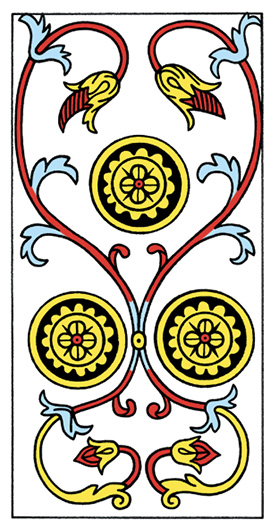
The productive and dynamic nature of the number three is expressed in the practical domain of coins as the first results of an effort or an investment. The illustration shows two coins above a plant decoration that looks gathered and enclosed. A similar decoration appears on top, more open and containing a third coin.
interpretation: A productive outcome of an alliance or partnership. First results, modest but real. Potentials starting to realize. Interpersonal tensions eased by working together on a common project.
inverse: Results too small compared to the effort. Collaboration ends in a disappointment.
stability
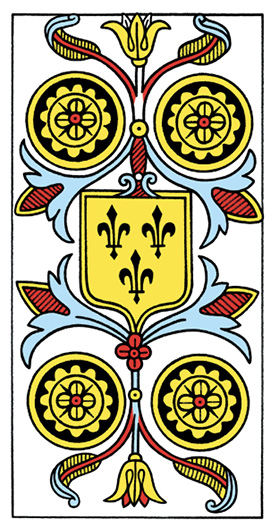
The conservative and practical nature of the number four fits well with the stable materiality of coins. The illustration shows a solid rectangle of coins decorated with large flowers and several dotted circles. At the center appears a shield with three fleurs-de-lys, the coat of arms of the French royal house of Bourbon.
interpretation: Material solidity, a secure base. Relations with respected and trustworthy institutions. Tradition, reputation, and honor. Reliability gained over time. Preserving the existing assets. Doing things in the old and time-tested ways.
inverse: A conservative attitude, rigidity, outdated perspectives.
disruption

The number five disrupts the solid stability of the four by adding a new element whose importance is magnified as it clashes with the conservative nature of the coins. The single coin at the center pushes the others to the margins and defines a big space for itself. But the pointed leaves in light blue above and below can signify a reaction from the existing structures that limits its movements.
interpretation: Disruption of stable patterns. Success in something new. A new and exceptional element assumes a central place but also arouses resistance. Risk of finding oneself outdated and pushed to the side. Need to pay attention to the old habits and the traditional structures.
expansion
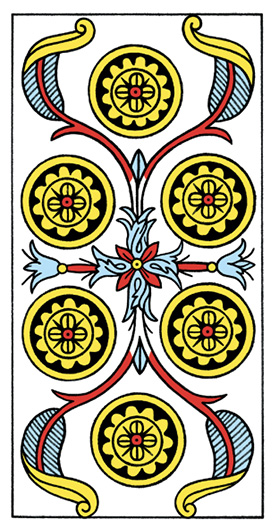
The harmonic nature of the number six is expressed in the suit of coins as plenty of resources and possibilities. Rich plant decoration grows from the center point with a vortex pattern in the middle. The arrangement of the coins integrates stability in the middle square, dynamic expansion in the two triangles above and below, and harmonic roundness in the overall elongated hexagon.
interpretation: Optimism; a positive outlook, especially in material and practical issues. A good balance between stability and flexibility. Advancement of projects without encountering a real challenge. Expansion in different directions without losing focus. Success.
acceptance
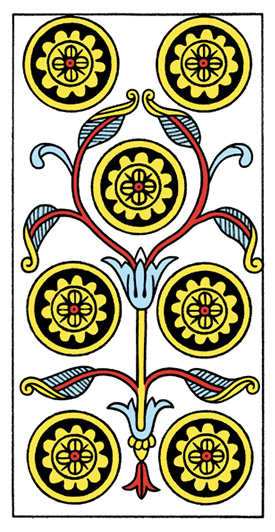
The practical aspect of the coins subdues the dynamic three to the stability of the four, with the number seven depicted as an inverse triangle pointing down at a rectangle. The single coin finds its place between the three pairs, well positioned but not overly dominant. The plant decorations enclose it in a way that expresses protection and support.
interpretation: A new or exceptional element is well-received in an existing framework. Help and support. Nourishment and protection. Balance between individualism and conformity.
inverse: Excessive dependence on external support. Constant need to be accepted and approved by others.
uniformity

The organized nature of the number eight is expressed in the practical domain of coins as a uniform and mechanistic structure. The card shows a regular pattern of four pairs of coins piled on each other. The plant decorations put each coin in its own separate box, but the developed flower at the center seems to combine them together into a working whole.
interpretation: Uniformity, regularity, conformity. Repetition of small tasks, a long and patient effort, routine. Profit achieved through hard work. Anonymity in a big system. Rational and pragmatic considerations. Machinery; something that works fine and achieves results but lacks a human touch.
motivation
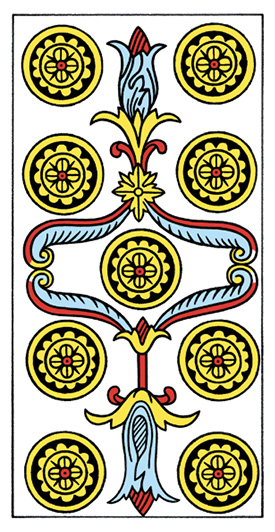
The number nine, looking forward to perfection, plants a seed for future practical advancement in the middle of a regular array of eight coins. The single coin at the center seems to be isolated in its limited space and pressured by the four pairs around it. But the big flowers above and below can indicate that its stamina and perseverance will bring positive results later on.
interpretation: Ambition, motivation, a desire to advance. Carving a niche for oneself in an existing system. Courage, endurance, readiness to continue in spite of difficulties. A nonconformist person or an unconventional idea looks strange and useless but may hold the key for future advancement.
abundance
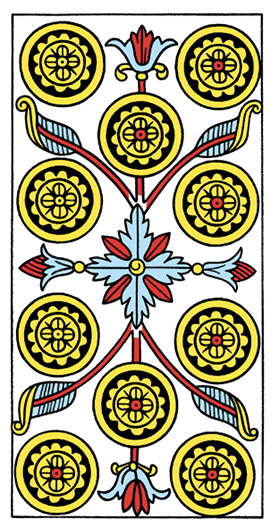
The number ten brings the material aspect of the coins into full realization. The card shows a large flower at the center with expanding tips. Around it are plenty of coins and plant decorations. The image suggests abundance in material things and a comfortable situation. The centers of the three coins at the top left are not colored red like the others.
interpretation: Abundance and plenty; a lot of money. Preoccupation with financial and practical issues. Stability with a possibility for further gains. Success and achievements. Excessive materialism. Too little attention to the needs of others. An unequal or unfair distribution of resources.
partnership

The duality of the number two is expressed in the emotional domain of the cups as a close relationship between two people. The middle plant grows from a stable base decorated with royal symbols. Its red shapes express passion and desire. The two legendary fish heads may be some kind of a garden fountain, but perhaps they are going to devour the flower between them.
interpretation: A romantic union or a warm partnership. A personal alliance grounded in social norms. Collaboration and trust. The prospect of marriage. Passionate love, but emotions can turn around and extinguish themselves.
inverse: A crisis in a couple relationship. A disappointment with someone you trusted.
birth
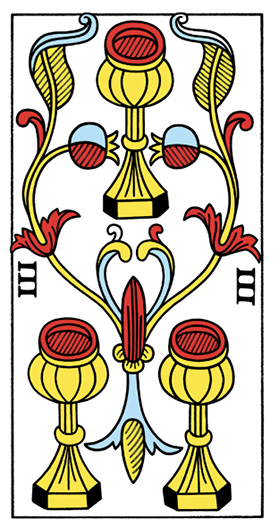
In the emotional cups, the creative nature of the number three generates the birth of something new from the affective alliance of two. The card shows a pair of cups with heart-shaped plant decorations growing from the red shape between them. A third cup appears in this protected and nourishing space, as if born from the union of the two.
interpretation: Something new is born, bringing happiness and joy. Creating something out of love. Childbirth or caring for a child. Issues about the relations of the querent with their parents.
inverse: A problem in relationships with a child or with parental figures. Feeling neglected.
family
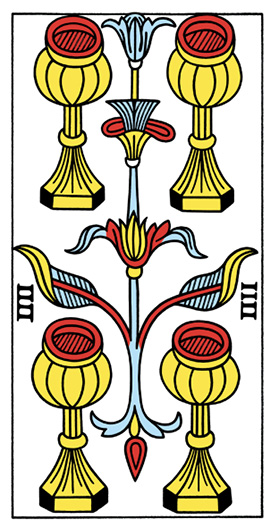
In the suit of cups, the solid number four generates a stable framework for emotional relationships, such as a family or a community. The illustration shows four cups in a square arrangement. The plant decorations connect them while giving each one its own place, and they create a central axis of stability and continuity.
interpretation: A stable framework of close human relationships: the family, a group of friends, a community, or a tribe. Secure feeling of belonging. Issues of family relations, especially between parents and children. Emotional stability.
inverse: Family problems. Quarrels and discord in a group.
links
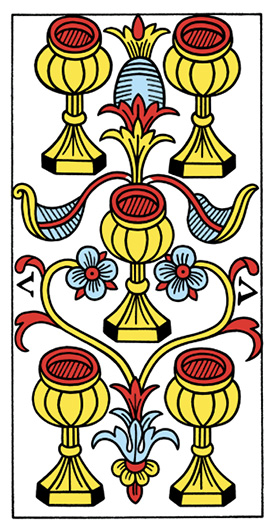
The number five adds a new element at the center of a stable structure. In the human relationships domain of the cups, it is expressed as an influential and well-connected personality. The single cup at the center is surrounded by rich and flowing plant decorations with a suggested fruit at the top. The plants connect all five cups into one group full of activity and movement.
interpretation: Developed social skills; many connections and links with other people. Popularity, ability to establish and maintain friendships. Active and lively dynamics in a group.
inverse: Excessive preoccupation with affairs of other people. Need to find a quiet place for oneself.
continuity
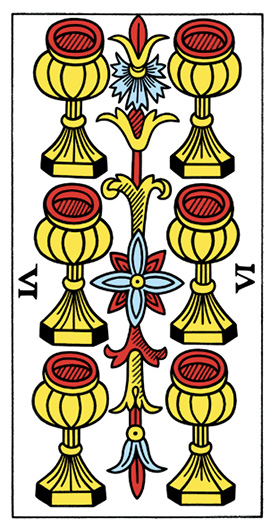
The harmonious character of the number six is expressed in the emotional suit of cups as long-term and reliable relations. The repeating pattern of three pairs of cups on top of each other is organized around an axis of plant decorations with a clear focus on the central flower. The attention is more on the continuous process than on the individual cups.
interpretation: A long-lasting marriage or a stable partnership. Continuity of different generations in a family. Feeling secure about a partner’s feelings.
inverse: Monotony, boredom, lack of novelty and interest in a relationship. A feeling of repetition without advancement. Recurrent emotional traps.
individuality
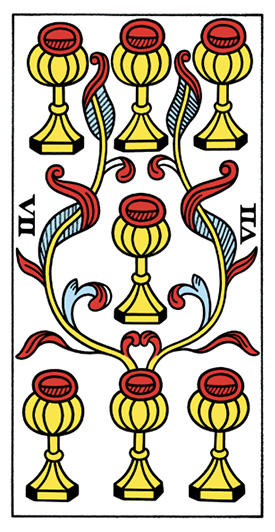
In the human relations domain of the cups, the number seven is interpreted as 1 + 6, an individual in a relation with a group. The card shows a single cup between two horizontal rows of three cups each. The plant decorations emphasize the central vertical axis, connecting the single cup with the two central ones above and below it.
interpretation: An individual integrating into a group while keeping their own position and values. Close relations with influential people. Exceptional qualities or a unique personality are appreciated.
inverse: Isolation and estrangement. Feeling lonely in the midst of a group.
involvement

The emotional touch of the suit of cups constructs the number eight as 6 + 2, more flexible and rich in combinations than the mechanistic and uniform 4 x 2 of the coins. The card shows a pair of cups between two rows of three above and below it. The plant decorations show a focused center and emphasize both the pairing of the two and their integration with the other six.
interpretation: Involvement of relatives and friends in a relationship or life of a couple. An extended family; many people interacting and interfering. A feast with friends or a family celebration.
inverse: Lack of privacy. Pressures from family or a social environment.
coordination
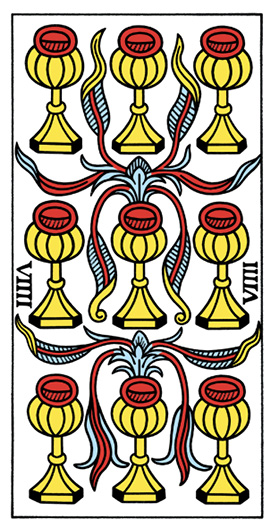
The number nine presents itself in the human relations domain of the cups as the complex group dynamics of 3 x 3 rather than the individual factor of 8 + 1, as in the coins. The card shows nine cups in a square array. The plant decorations mark a separate space for each one but also express movement and interaction. The abundance of cups and leaves looks happy and radiating.
interpretation: General harmony; every person or part is in its proper place. A complex but productive group dynamic. Feeling oneself part of a collective. Happiness in normal life and simple relationships.
inverse: Difficulty in finding one’s place in a group. Confusion in a complex social situation.
leadership
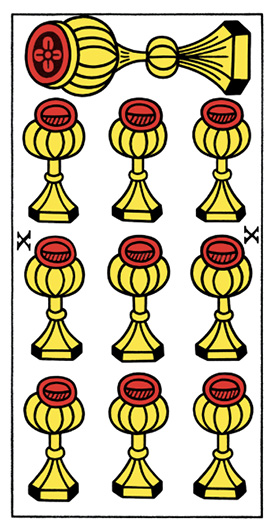
The number ten completes the social construction of the cups by putting one on top of the other nine, expressing the collective as a unity of a higher order. The card shows a large cup lying on its side over a group of nine smaller ones. Its mouth pattern resembles the coin icons, and it may be pouring nourishment on the others. There are no plant decorations, and the focus is only on the cups and their relations.
interpretation: A leading figure. A position of responsibility and guidance for others. Caring for those dependent on you, but maybe this leaves you little space for yourself.
inverse: A leader toppled. Loss of popularity. Ingratitude from people that you helped.
crossroads
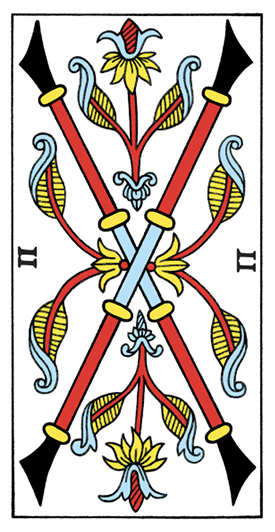
The duality of the number two is expressed in the forward-moving suit of wands as a junction of two ways. The card shows a crossing of two wands with rounded yellow bands that give the card an easy and optimistic feeling. Plant decorations flow from the center to all directions, perhaps indicating that in whatever way the querent chooses to go, they may find advantages and the potential for success.
interpretation: Two or more ways open before the querent, all of them promising. Stopping for a moment before taking a decision that will bear long-term consequences. Meeting someone going their own way as both paths cross each other.
in a conflict: Trying to block someone by cutting their line of advance.
direction
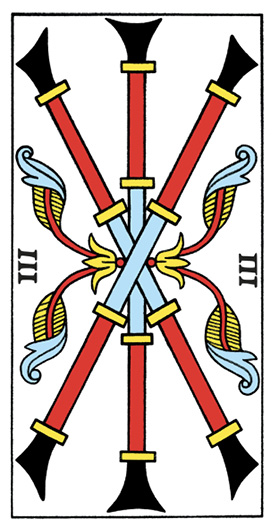
The number three adds a third element to the junction of the two, thereby giving a clear direction to the dynamic wands suit. In the card a central wand passes under the intersection of two others, as if adding a new path to the junction in the previous card. The plant decorations are minimal, but their tips at the card edges are sharp and pushing outward.
interpretation: Finding a way after a period of hesitation. A solution to a dilemma, perhaps combining elements from both sides. Time to go forward. Choices can still be reversed, but soon it will be impossible.
in a conflict: A third party profits from keeping itself noncommitted between opposing sides.
stalemate
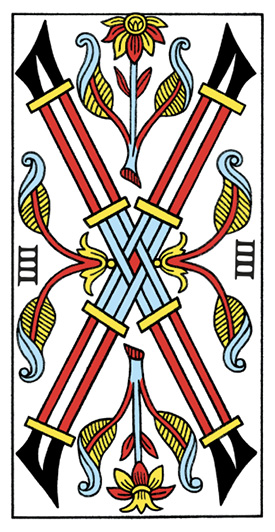
The static number four freezes the movement of the dynamic wands. The four wands are interlocked so that none of them can easily move. The plant decorations are rich and flowing, but the spreading red shapes may hint at suppressed energy and tension. The top flower seems to be older than the bottom one, perhaps indicating that things continue to evolve under the surface immobility.
interpretation: A temporary rest. Preparing a base for future advancement. Time to enjoy previous achievements. Change will come, but not right now. Existing tensions are the source for new and creative future moves.
in a conflict: A stalemate. It may be dangerous or harmful to move now.
overcoming
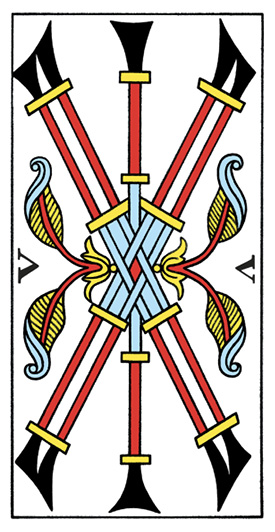
The number five introduces a new element that breaks the stalemate of the four and enables the dynamic wands suit to advance. In the card a single wand passes under four interlaced ones. The plant tips recede from the card edges, focusing attention on the action at the center. Just above the crossing, the single wand covers the edges of the perpendicular yellow bands as if overcoming their opposition.
interpretation: Breakdown of equilibrium. Opposition and difficulties, but not too hard to overcome. Focusing attention on a main effort.
in a conflict: Seizing the moment to make a winning move.
inverse: (with the covering part of the central wand below) Walking into a trap. Losing an advantage.
collaboration
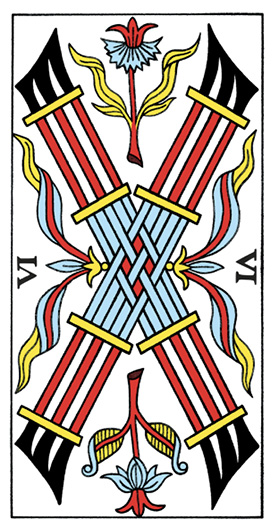
The harmonious number six integrates as 3 + 3 two opposite movements of the wands suit. The card shows two bundles of three wands each, interwoven to form a strong and durable structure. The plants in three directions have long and narrow leaves with sharp tips undulating to the card edges. The top flower has a sort of a fancy collar.
interpretation: An alliance between two parties with different goals but common interests. Pushing to advance in various directions. A taste for luxury made possible by favorable conditions, but misplaced if the decorated flower is below (inverse).
in a conflict: Finding an ally. Breaking up the alliance of opponents.
struggle
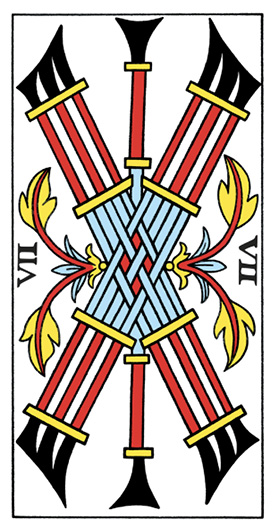
The conflictual aspect of the wands interprets seven as one standing against six. The card shows a single wand passing through a mesh of six interlaced ones. Different segments of the single wand are misaligned, as if passing through the mesh has its price. The plant leaves look like sharp blades with tips curving in. They can also resemble flames or sparks flying around from the central conflict area.
interpretation: Present difficulties may be overcome, but at a price. A situation that pits one against many. Striving to keep one’s own way even when it involves clashes with the environment. Persistence, endurance.
in a conflict: A hard struggle with an uncertain outcome.
regulation
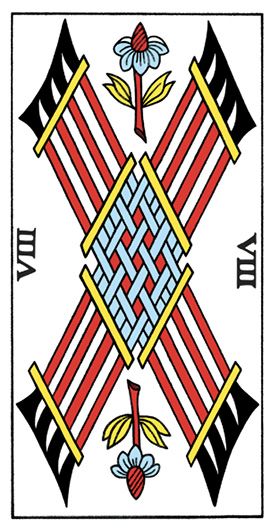
The structured character of the number eight organizes the movements of the wands suit in a complex array of clearly marked paths. The card shows a symmetrical structure of eight interlaced wands. The center can resemble a woven mat, but also a maze of crossing paths in which one can get lost. There are no plant decorations on the sides. The upper flower has white petals at the top.
interpretation: A controlled environment in which one can go only in certain predefined ways. Getting lost in rules and regulations. Putting one’s thoughts and actions in order.
if the white petals are on top: The existing rules can work in the querent’s favor.
in a conflict: A tight, complex situation. A roadblock.
interruption
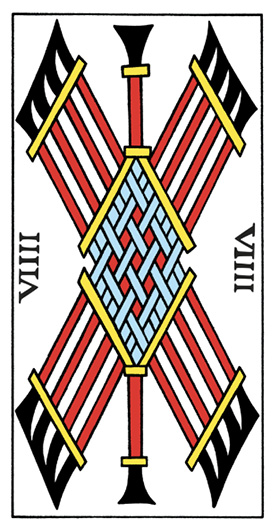
The intricate currents of the number nine derail the aspiration of the dynamic wands suit to go straight ahead. The cards show a single wand divided into two parts by the crossing bundles of four wands each. Unlike in previous odd cards, we cannot see the single wand continuing into the middle mesh. There are no plant decorations.
interpretation: Difficulties and oppositions force the querent to stop. It is possible to resume progress later, but from a new position. Spending energy in continuous efforts and struggles. No time to relax.
in a conflict: Avoiding a clash with superior forces by letting them have their way.
loyalty
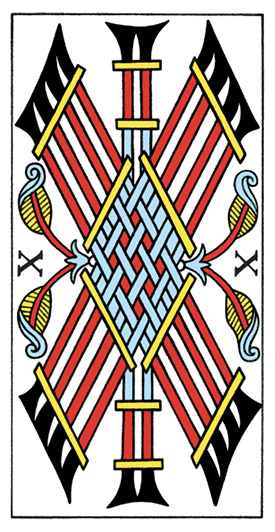
The number ten creates an alliance of two, thus making the dynamic wands overcome the heavy entanglement of eight. The card shows two connected wands passing beneath a crossing of eight and reemerging together. The lateral plant decorations that disappeared in previous cards appear again, growing from a small white circle on each side.
interpretation: A partnership or a couple’s relationship goes through a difficult period but endures it without falling apart. Someone you can trust in times of trouble. Persistence and pure intentions pay off.
in a conflict: Success is achieved by remaining loyal to one’s friends and principles.
boundaries
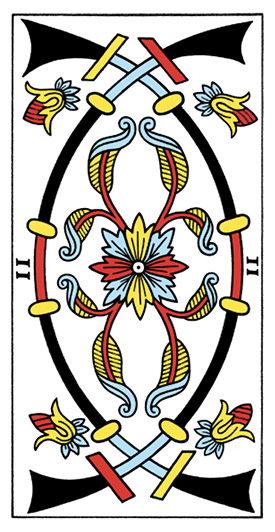
The dividing swords suit expresses the duality of two as a first separation between inside and outside. Two arching swords mark the boundaries of an elongated space. A symmetrical flower with a central focusing symbol is shown inside in top view. It seems to be growing comfortably in its assigned space. The arching swords carry perpendicular yellow bands with rounded edges.
interpretation: Boundaries and limits, not only blocking but also protecting and defining a space for growth. Taking full advantage of the existing conditions. Preparations for future advancement, but without crossing any borders yet. A clear perception of a situation, which is both focused and encompassing.
victory

With the decisive and penetrating aspect of the swords, the dynamic number three overcomes the boundaries of the two. A single upright sword breaks through a crossing of two curved ones. It looks thicker and more solid, and it is decorated with two bay laurel branches, which are a traditional symbol of victory. One flower tip, the cross-guard, and the pommel button of the upright sword are white.
interpretation: A victory or a breakthrough achieved without much difficulty. Pure intentions and righteous conduct win the day. Cutting through a dilemma or a quandary. A third party intervenes in a quarrel of two and wins over both.
inverse: Defeat. Failure in an attempt to make a decisive move.
restriction
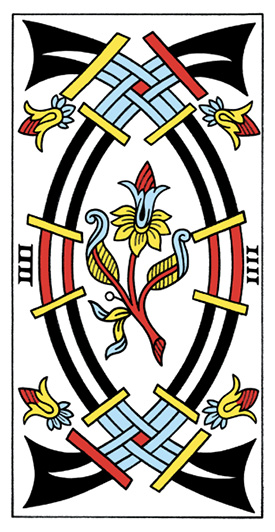
The static number four brings out the blocking and limiting aspect of the swords. Two pairs of curved swords create a solid border around the center. In the middle a branch in side view completely fills the enclosure. It looks constrained, with a narrow top flower and the tip of the right-hand leaf touching the swords. Emerging on the left of the branch is what seems like a tiny white berry on a stalk.
interpretation: A stable but limited situation. Pushing against boundaries. Working under pressure and constraints. A potential for future growth that cannot fully express itself in the present conditions.
inverse: Limitations and confinement. Giving up an attempt to break out of an oppressive situation.
breakthrough
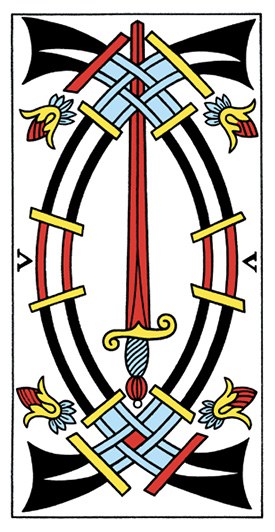
The subversive nature of the number five is expressed in the active suit of swords as a forward push that breaks through the existing barriers. A single upright sword with a white pommel button, thicker than in all the other odd cards, pushes its way out of a space confined by four curved swords. We can see its continuation as it passes inside the upper interlacing of the arches.
interpretation: An initiative to push forward and go beyond the present limitations. Perseverance in a tight situation brings success. Going your own way regardless of disturbance by others. Imposing your will on adversaries who are weaker.
inverse: Failure to change things by brute force
adaptation
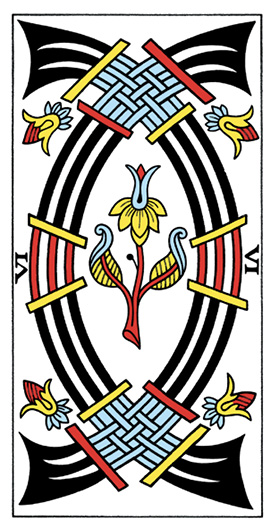
The harmonic and easy-going character of the number six accepts the limits imposed by the blocking aspect of the swords. The branch in the middle of the enclosure formed by six curved swords adapts its form to the available space, keeping a neat distance from the borders on all sides.
interpretation: Accepting the limits of the situation and adapting oneself to them. Giving up personal ambitions in order not to disturb the present balance. Making the best of the present conditions.
inverse: Resignation, surrender, despair.
sharpness
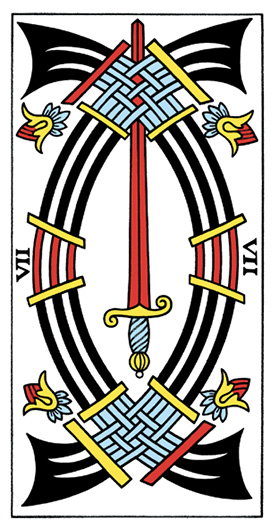
Both hard suits interpret seven as one against six, but the swords give the single element sharpness and determination. In the card a single sword pierces its way through a mesh of six curved swords, grazing the tips of their side bands as it passes. It looks straight, narrow, and efficient, with a single line running the length of its blade.
interpretation: Focus and determination. Fighting with a clear goal in mind. Concentrated will and a no-nonsense attitude, but keeping the original motivation pure. Winning over an opponent where the forces are roughly balanced.
inverse: Sharp skills and determination expressed in a wrong direction.
defenses
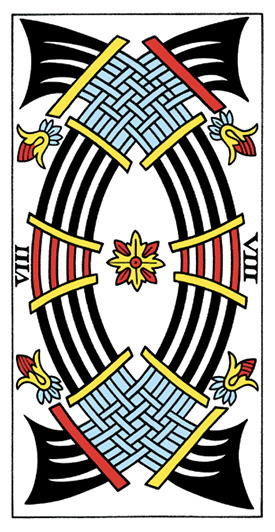
The structured number eight expresses the separating aspect of the swords as elaborate shields and defenses. The card shows a small symmetrical flower with a central focusing symbol heavily protected by two thick bundles of arched swords. But its colors integrate well with the middle sections of the swords, and the curved yellow bands provide a sense of a possible opening.
interpretation: A defensive attitude, putting up shields and protecting walls. Psychological defense mechanisms and rationalizations. Feeling safe but isolated and blocked. Loss of motivation to change things. A hidden asset or treasure, well protected and difficult to reach.
courage
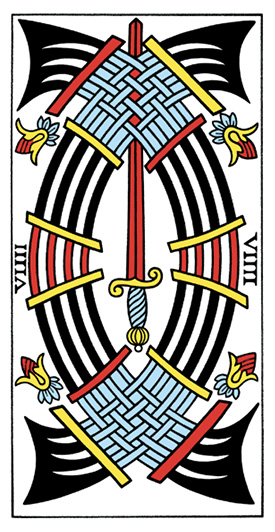
The determination of the swords overcomes the inner confusion of nine. In this card a single sword pushes its way out of an enclosure formed by eight arching swords. In spite of the thick barrier and the limited space for maneuver, it boldly goes its way and passes through. Its different segments are not properly aligned.
interpretation: Winning a battle against superior forces through courage and determination. Keeping up hope in a difficult situation. Pushing forward with imperfect means.
inverse: Losing a fight against a stronger opponent. A battle lost in advance. Sloppiness and lack of necessary preparations lead to failure.
exhaustion
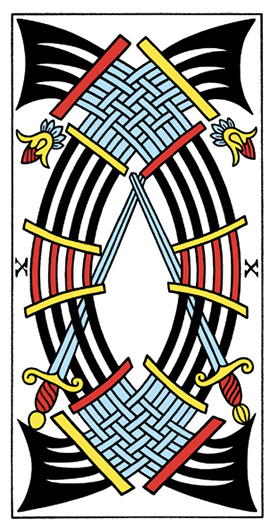
The number ten maximizes the combative aspect of the swords. But with so many weapons and clashes, they just neutralize each other. In the card two straight swords penetrate the space between the arches. They are crossed, as if in a duel, but their bases are stuck and cannot move. The left sword, with a plain pommel, has a gap in the middle, and its tip is covered by the other sword.
interpretation: A period of battles and clashes leaves all the sides exhausted. A complex situation with many conflicting interests. A sophisticated approach will win over a simple one. Finding an ally to confront the situation from another angle.
inverse: Immobility. Feeling attacked from various sides.